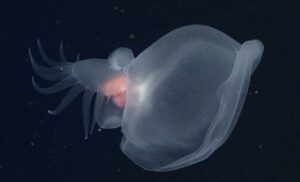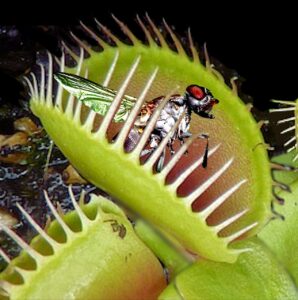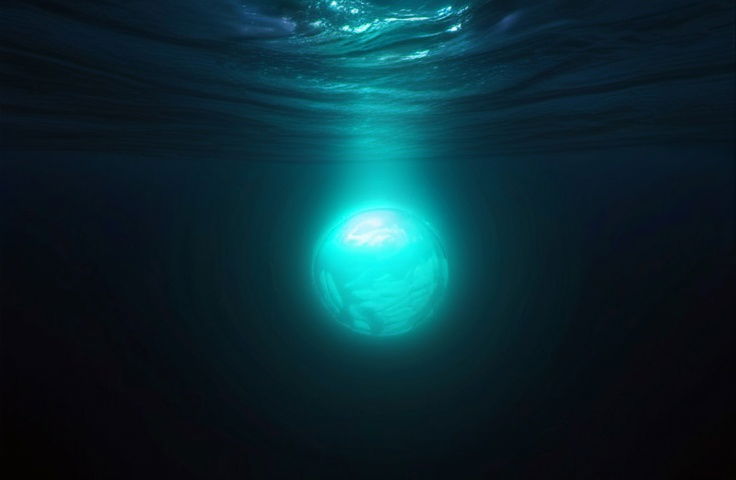Researchers from the Monterey Bay Aquarium Research Institute (MBARI) who spotted a mysterious glow in the depths of the Pacific Ocean’s pitch-black ‘Midnight Zone’ years ago led to the discovery of a completely new life form, according to new findings.
Nicknamed the “mystery mollusk,” the newly discovered Bathydevius caudactylus is a type of sea slug, or nudibranch, that lives in the perpetual darkness of the ocean’s midnight zone. Also known as the bathypelagic zone, the midnight zone ranges between 1,000 and 4,000 meters below the surface.
Like many creatures living in this sunlight-starved environment, the animal is bioluminescent, meaning it can create its own light source to confuse or distract predators. According to the MBARI researchers behind the mystery mollusc’s discovery, the creature’s ability to light up caught them off guard the first time it happened.
“When we first filmed it glowing with the ROV, everyone in the control room let out a loud ‘Oooooh!’ at the same time,” said MBARI Senior Scientist Steven Haddock. The scientists added that the team “were all enchanted by the sight.”
In one instance, the team says it also saw the mystery mollusc illuminate and then detach an appendage that continued to glow as it descended toward the ocean floor. They suspect this behavior is similar to a lizard detaching the end of its tail so its continued movement can distract a predator while the animal escapes.
Midnight ZOne Mysterious Glow Launches 20-Year Study
The MBARI teams’ first sighting of their mystery mollusc occurred in February 2000 during a dive with the institute’s remotely operated vehicle (ROV) Tiburon off the shores of Monterey Bay. At 2,614 meters (8,576 feet) deep the team spotted a hooded, mostly transparent animal floating along with the currents.


Since that initial sighting, the MBARI researchers have logged over 150 additional sightings in the past 20 years. These sightings include watching the animal swim, drifting with the currents, trapping and eating prey, and even descending to the ocean floor to lay eggs.
“We’ve invested more than 20 years in understanding the natural history of this fascinating species of nudibranch,” said Robison, noting that the team witnessed several instances of the creature emitting its mysterious glow. “Our discovery is a new piece of the puzzle that can help better understand the largest habitat on Earth.”
The study authors say that observing an animal at these depths has made discovering such species unusually difficult. And studying them with this level of clarity was only possible due to the cutting-edge equipment provided by the institute.
“Only recently have cameras become capable of filming bioluminescence in high-resolution and in full color,” Haddock explained. “MBARI is one of the only places in the world where we have taken this new technology into the deep ocean, allowing us to study the luminous behavior of deep-sea animals in their natural habitat.”
“Thanks to MBARI’s advanced underwater technology, we were able to prepare the most comprehensive description of a deep-sea animal ever made,” Robinson added.
Team Initially Struggled to Identify Mystery Mollusc
As part of their study, the team says they “gently” captured a mystery mollusc specimen and examined it more closely in a laboratory setting. During that analysis, the team found several anatomical differences between their mystery mollusk and similar nudibranch species.
For example, it had a “voluminous hooded structure” at one end and a flat tail “fringed with several finger-like appendages” on the other. The creature’s skin was almost perfectly transparent. Although likely a survival adaptation to make it harder to detect, this transparent skin revealed a series of bright, colorful organs inside. Because the animal combined these unique attributes with a foot like a snail, the team says they “initially struggled to put the animal in a group.”
Genetic tests ultimately confirmed that their newly discovered creature with the mysterious glow was indeed a distant relative of other sea slugs, making it a nudibranch. However, the mystery mollusk’s DNA was different enough from that of other species that they decided to place it in its own family, Bathydeviidae.
The research team also details the mystery mollusc’s habitat and observed behavior in their study. For example, they found that their sea slug can not only emit a mysterious glow but also capture and eat prey by trapping it under its large hood, similar to the way a Venus Flytrap captures flies.


The researchers note that two other nudibranch species, the lion’s mane nudibranch (Melibe leonina) and the veiled nudibranch (Tethys fimbria), also use a hood to capture prey. However, the newly discovered mystery mollusc is likely from an entirely different evolutionary branch, making this behavior more likely an example of convergent evolution than inherited. Some additional undersea animals, including jellies, anemones, and tunicates, also trap prey with this method, but they are entirely unrelated to the nudibranch.
For locomotion, the mystery mollusc flexes its body up and down in a flapping-like motion. It can also make a quick escape by ejecting a blast of water from its rapidly closing oral hood, similar to how a jellyfish can collapse its bell to escape predation rapidly. For the researchers involved, watching this meterious creature navigate its stygian environs shows how much we still have to learn about this vast, undiscovered habitat.
“What is exciting to me about the mystery mollusc is that it exemplifies how much we are learning as we spend more time in the deep sea, particularly below 2,000 meters,” said Haddock. “For there to be a relatively large, unique, and glowing animal that is in a previously unknown family really underscores the importance of using new technology to catalog this vast environment.”
Unraveling the Mysteries of the Largest Habitat on Earth
Sightings of mystery molluscs have ranged from Oregon to Southern California, making this their likely habitat. However, a separate team of NOAA researchers may have spotted a similar creature with the same features and mysterious glow in the Pacific Ocean’s Mariana Trench. This sighting could mean the animal’s distribution is more widespread if confirmed.
Notably, the discovery of the deep sea creature with the mysterious glow is not MBARI’s first. According to the study authors, the institute’s technology has been used to discover and document more than 250 previously unknown deep-sea species.
“Deep-sea animals capture the imagination,” said Robinson. “These are our neighbors that share our blue planet. Each new discovery is an opportunity to raise awareness about the deep sea and inspire the public to protect the amazing animals and environments found deep beneath the surface.”
“The more we learn about deep-sea communities, the better we will be at ocean decision-making and stewardship,” Haddock added.
The study “Discovery and description of a remarkable bathypelagic nudibranch, Bathydevius caudactylus” was published in Deep Sea Research.
Christopher Plain is a Science Fiction and Fantasy novelist and Head Science Writer at The Debrief. Follow and connect with him on X, learn about his books at plainfiction.com, or email him directly at christopher@thedebrief.org.

